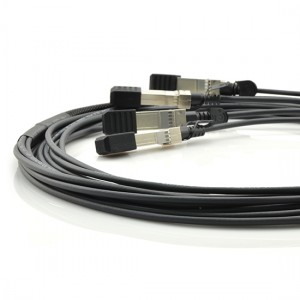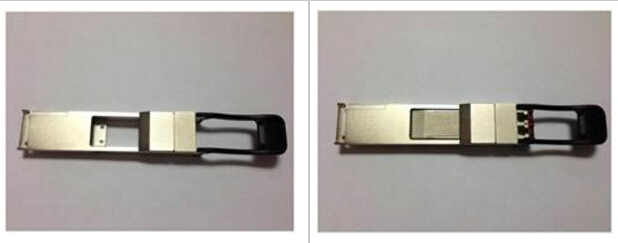When one end of the network is running on a 40 Gigabit platform, and the other end of the network is running at lower speeds such as 10 Gbps, migration is required. Using fan-out technology and CVR-QSFP-SFP10G QSA are two different methods to achieve the migration between 40 Gigabit Ethernet and 10 Gigabit Ethernet. But which is better?
Expands the 40G Data Pipe into 4x10G Lanes With Breakout Cables
40G QSFP+ to 4×10 SFP+ breakout cables including direct attach copper cable (DAC) and active optical cable (AOC) can take a 40 Gigabit physical interface and break it out into four SFP+ interfaces, converting the downlink 40G port of ToR (Top of Rack) access layer switch into 4x10G channels then connect to the cabinet server port. Thus, they are considered as the most cost-effective solution for 10G to 40G migration in short-reach interconnect environment.

Converting a QSFP+ Port to an SFP+ Port With CVR-QSFP-SFP10G QSA
QSA (Quad Small Form-Factor Pluggable Adapter) is the first solution for the QSFP+ to SFP+ conversion challenge in the world. It enables smooth connectivity between devices that use quad lane ports and 10 Gigabit Ethernet hardware that uses SFP+ based cabling. In other words, with QSA, you can effectively use a QSFP or QSFP+ module to connect to a lower-end switch or server that uses an SFP+ based module.
QSA module is built in a QSFP+ form factor with a cage for SFP+ module at the back. When inserting an SFP+ into a QSA connected to a 40 Gigabit port, QSA acts as an interface for the SFP+. This interface enables you to directly plug in an SFP+ originating at a 10 Gigabit Ethernet port on a switch or server.

40G QSFP+ to 4×10 SFP+ Breakout Cables vs. CVR-QSFP-SFP10G QSA
As mentioned above, we can use QSFP+ to 4x10G SFP+ breakout cables to split a 40 Gigabit port on a switch or a server into four 10 Gigabit ports. Or use QSA to convert a QSFP+ port to an SFP+ port. However, which one is better for an optimal ROI (Return on Investment)? Obviously, the former is more cost-effective for these reasons:
- Technology and products of QSFP+ to 4x10G SFP+ breakout cables are more mature in today’s market. Users can even use the 3rd party product without considering the problem caused by vendor lock-in.
- QSFP+ to 4x10G SFP+ breakout cables split the 40G channel into 4x10G channel which provides four times more data transfers compared to a QSA that just provides connectivity only for a single 10G connection.
- QSFP+ to 4x10G SFP+ breakout cables support both DAC and optical connectivity, and are cheaper than the expensive QSA.
Summary
40G QSFP+ to 4×10 SFP+ breakout cables and CVR-QSFP-SFP10G QSA modules can both be used for migration between 40G and 10G ports. But considering cost, performance, and compatibility actual environment, the 40G QSFP+ to 4×10 SFP+ breakout cables seem to be better. FS.COM offers a wide range of 40G QSFP+ to 4×10 SFP+ breakout cables including QSFP+ to 4×10 SFP+ DACs and QSFP+ to 4×10 SFP+ AOCs, which are 100% compatible for various platform, like Cisco, HPE, Juniper, and so on. For more information, please visit www.fs.com or contact sales@fs.com.
| Buyer Guide: FS.COM offers cost-effective and highly compatible QSFP BiDi transceivers which are tested to ensure 100% Cisco compatibility. | ||
| Categories | Description | |
| 40G QSFP+ to 4xSFP+ DAC | Every cable is individually tested on corresponding equipment such as Cisco, Arista, Juniper, Dell, Brocade and other brands, passed the monitoring of Fiberstore’s intelligent quality control system | |
| 40G QSFP+ to 4xSFP+ AOC | ||



